In my examination of the various exotic forms that naval architects have come up with, so far we've stuck purely to various forms of displacement hull, where the force that keeps the ship from sinking is provided entirely by water being pushed out of the way. But this leaves the entire hull in the water, which in turn means lots of resistance when trying to go fast. So for really fast ships, there needs to be some other method of providing "lift" which keeps more of the hull out of the water.
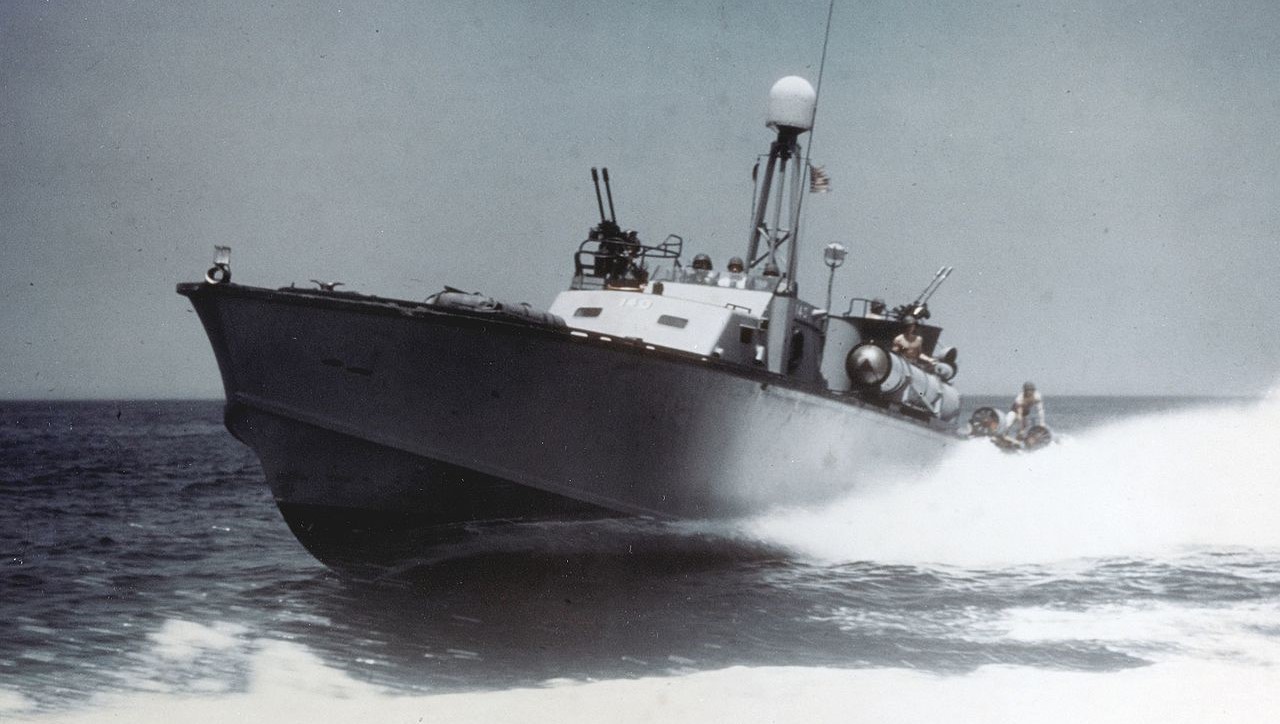
A US PT Boat planes
The oldest and most common of these methods is known as "planing". To take a simplified model, if a flat plate is towed through the water with the forward end higher than the back end, it will deflect water downward, which in turn will push the plate up, producing lift much like an airplane's wing does.1 This is the basic mechanism behind all planing craft, and has the advantage that once the majority of lift is provided by planing, the resistance grows more or less linearly with speed, a far less onerous scaling than experienced by a displacement hull. But planing as a concept runs into another problem: the amount of lift required to plane varies with the weight of the craft divided by the area of the bottom,2 a ratio that rises with vessel size. The result is that while a surfboard can plane while falling down a wave and a jet ski can often plane at 20 kts, bigger craft need a lot more speed to get on the plane, putting it out of reach of anything over 50-100 tons, which means that military use is limited to fast coastal craft like torpedo boats rather than proper warships.
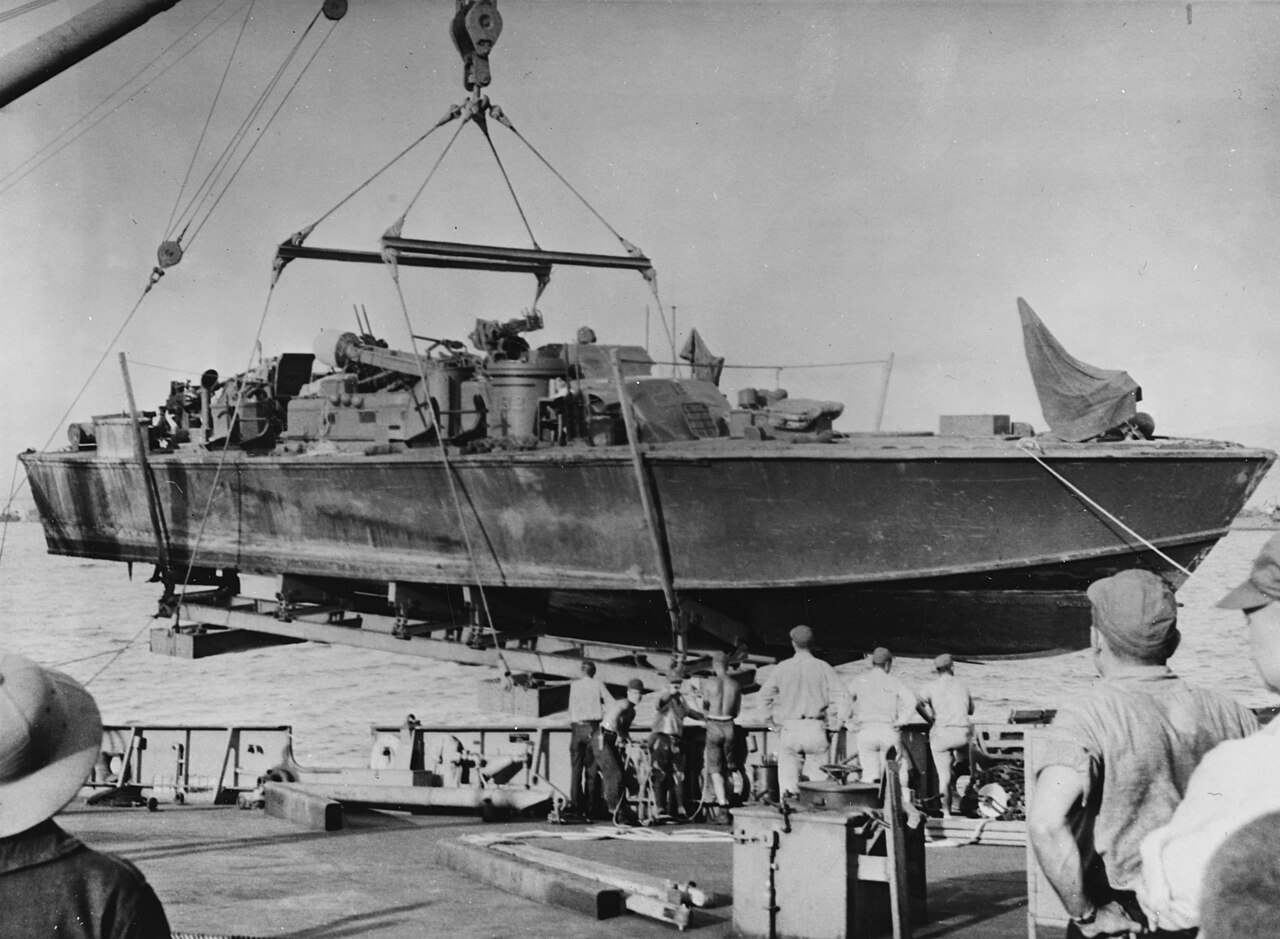
A US PT boat is hoisted aboard a repair ship, showing chines
While a flat bottom is ideal for planing performance in calm water, it tends to slam and pitch unacceptably when dealing with rough seas, so military planing craft have adopted a hard-chine hull, with flat sides to the hull and a bottom that is a shallow V. This cuts through the waves somewhat, although attempting to maintain high speed in rough seas, particularly if driven directly into them, can still result in an extraordinarily rough ride. Planing imposes unique structural loads, both from trying to go fast through rough seas and from the bow rising unsupported out of the water. For absolute best planing performance, the stepped hull was developed, which was cut away aft to allow the ship to ride on a small patch amidships and another aft, minimizing frictional resistance, the dominant source of drag at high speed. This imposed even worse structural problems than normal planing, and was generally thought to have worse rough-water performance,3 so it was rare in torpedo boats and the like but extremely common in seaplanes, which had to reach even higher speeds while planing during their takeoff runs.4
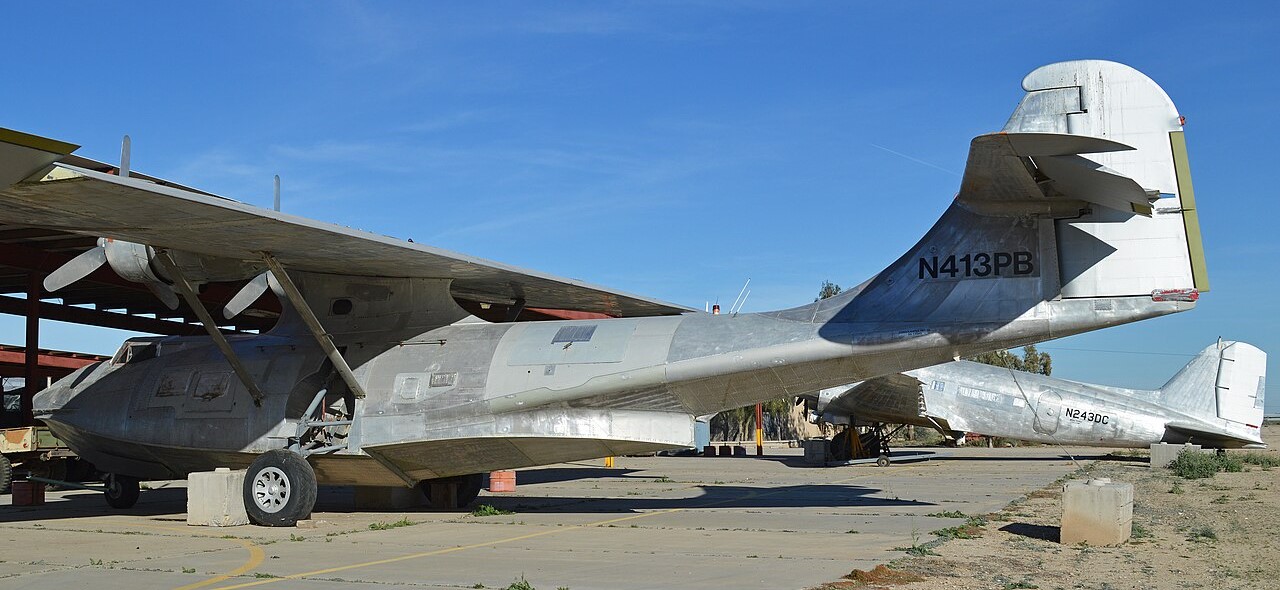
A stepped planing hull, visible on a PBY Catalina
But if water could be used to provide lift, then wouldn't it be better to use the most efficient lift-generating device known to do so? If you put a wing underwater, you could lift the hull entirely clear of the sea, which would not only cut friction, but also allow a vastly smoother ride in rough water, and might enable larger vessels to make high speeds. The basic concept, known as the hydrofoil, was first tried in the early 20th century, but it remained a curiosity until after WWII thanks to a number of practical problems.
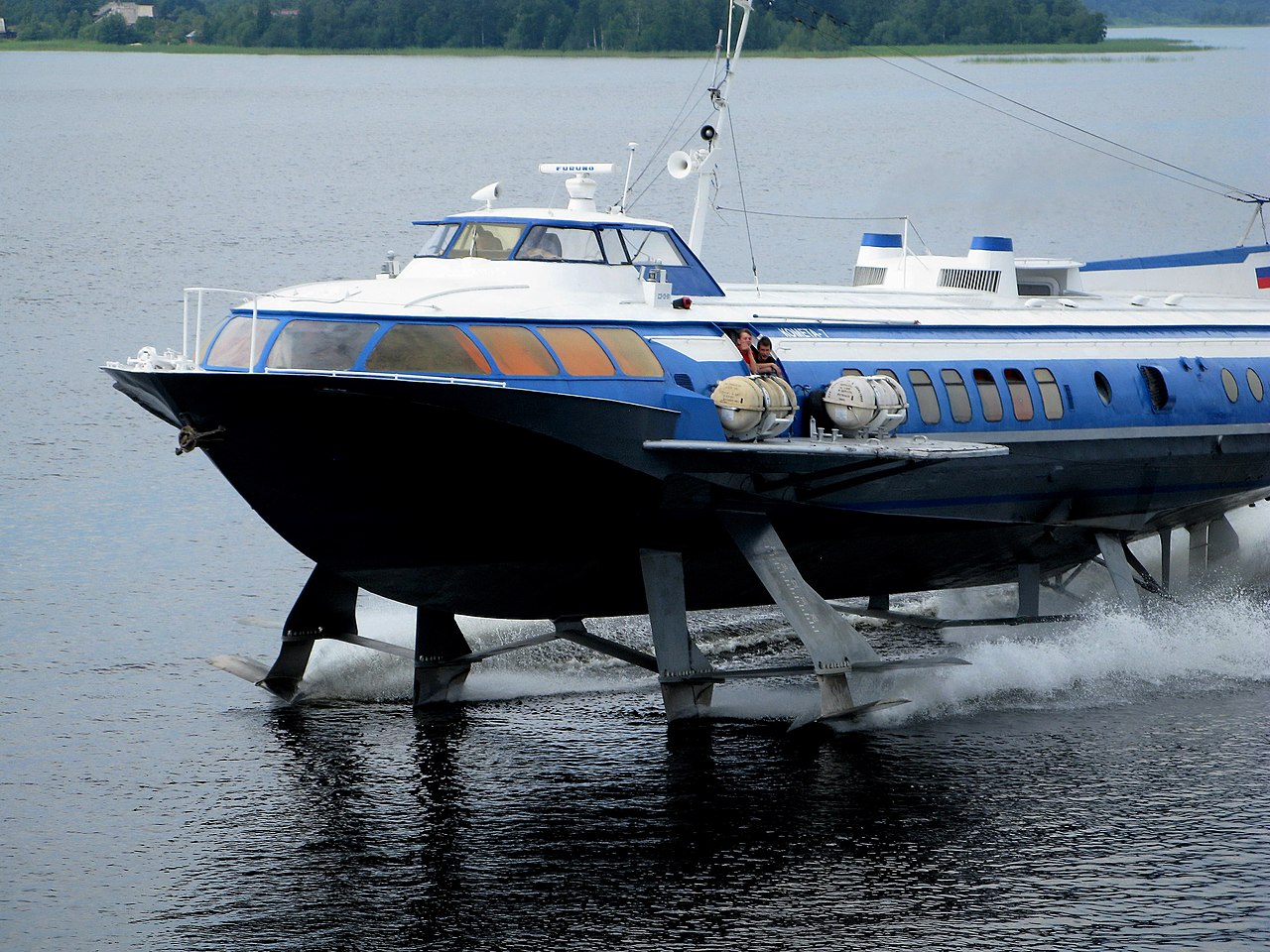
A Russian hydrofoil ferry with surface-piercing foils
The biggest of these was stability. For a given wing configuration, lift varies with the square of velocity, so just sticking a wing in the water is only going to work at a specific speed. Clearly, an effective hydrofoil will need to vary either the amount of wing in the water or the angle of the wing5 to control how much lift is being produced and match that to weight. A number of early designs used ladders, several horizontal foils stacked on top of each other, with the upper foils rising out of the water as the craft accelerates. More common is to use a V-shaped surface-piercing foil which becomes partially exposed, and which also provides stability in roll as the downward side of the foil goes deeper into the water, providing more force on that side to right the ship. This has the advantage of simplicity, and works great in calm seas. The disadvantage comes when things get rough, because waves also change how much foil is exposed and this means that some of the sea's motion gets transmitted to the hydrofoil. The alternative is a fully-submerged hydrofoil, which uses an active control system to vary how much lift is being produced, thus allowing it to more or less ignore the effects of waves that aren't big enough to reach the main hull. Of course, this is significantly more complicated than a surface-piercing foil, and it took quite a while for these to become widespread.
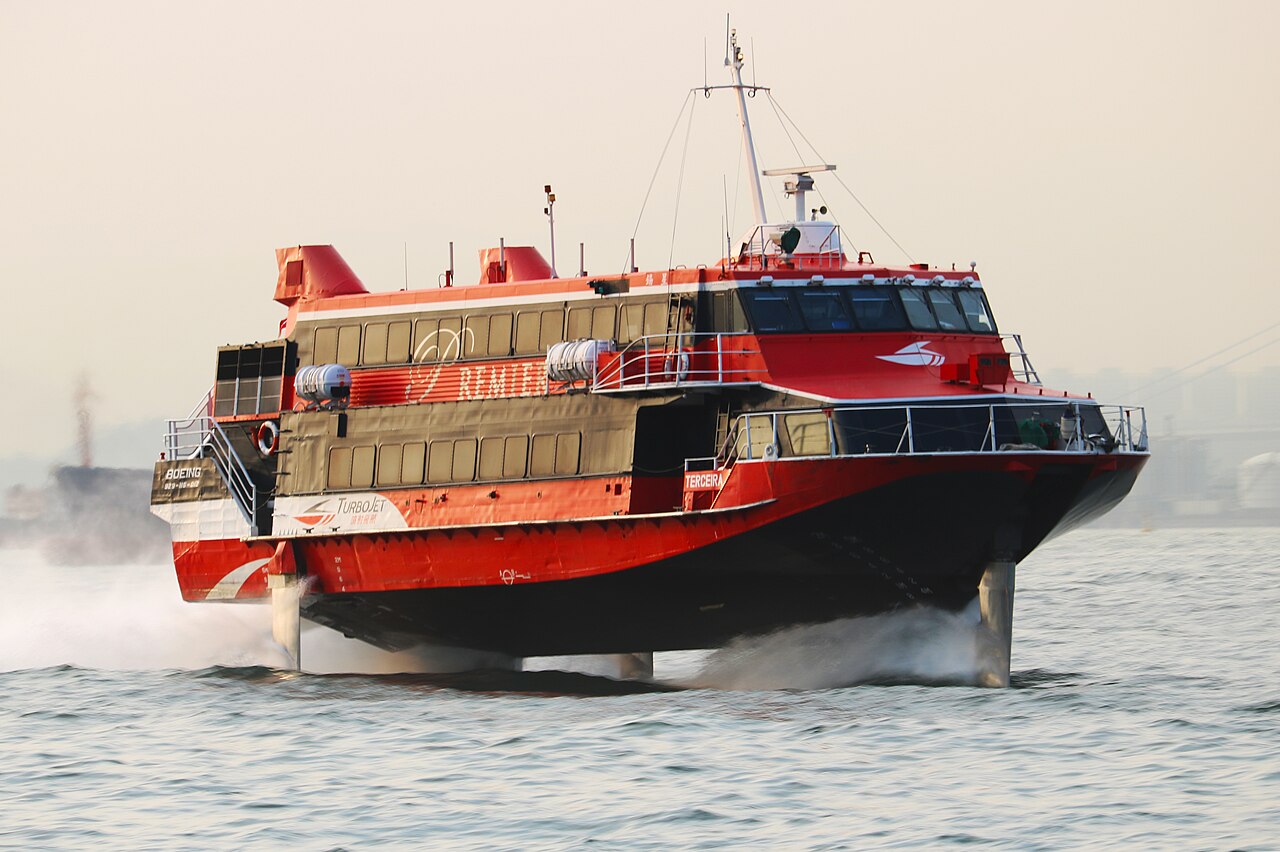
A Boeing 929, with submerged foils
Starting in the late 50s, hydrofoils became a serious player in the high-speed passenger ferry market, particularly on inland waters. For relatively short distances where the seas wouldn't be particularly rough, surface-piercing hydrofoils offered a significant upgrade over other options, and the Soviets in particular adopted them widely, often stacking surface-piercing foils, probably to make docking easier. Besides Soviet exports to a surprising number of countries, a few other nations built similar ferries, but it remained a fairly niche market. The most prominent Western hydrofoil ferry is the Boeing 929 Jetfoil,6 a 70s design that uses fully-submerged foils and waterjets to provide a speed of 45 kts or so. A number remain in use in Japan, and it also spent decades as the main ferry connecting Hong Kong and Macau.
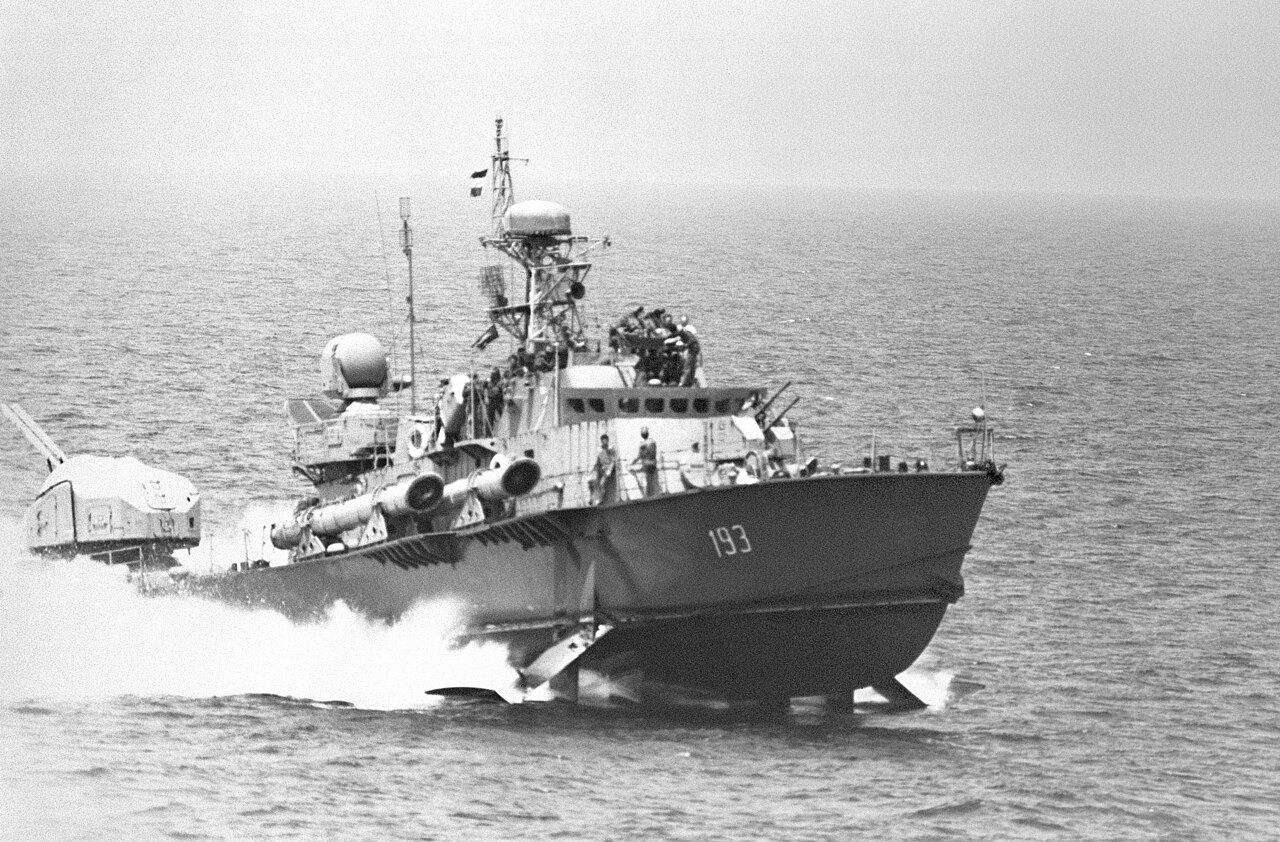
A Turya class torpedo boat hydrofoils
There was also interest in the technology for military use, and many navies bought experimental hydrofoils, including Britain, the US and Canada. Operational use was more limited, although as might be expected, the Soviets were a major adopter, although in a rather odd way. With the exception of a single pure hydrofoil, which they apparently didn't like enough to make more of, all Soviet military hydrofoils were a rather odd hybrid type, essentially an existing missile or torpedo boat with surface-piercing fins forward and the hull planing aft. This gave a little bit more speed to already-fast hulls, but does not seem to have been particularly successful, with about 50 Turya class torpedo boats and a dozen Matka class missile boats being built. To put these numbers in context, the Matka was derived from the conventional Osa class, which had over 400 units.
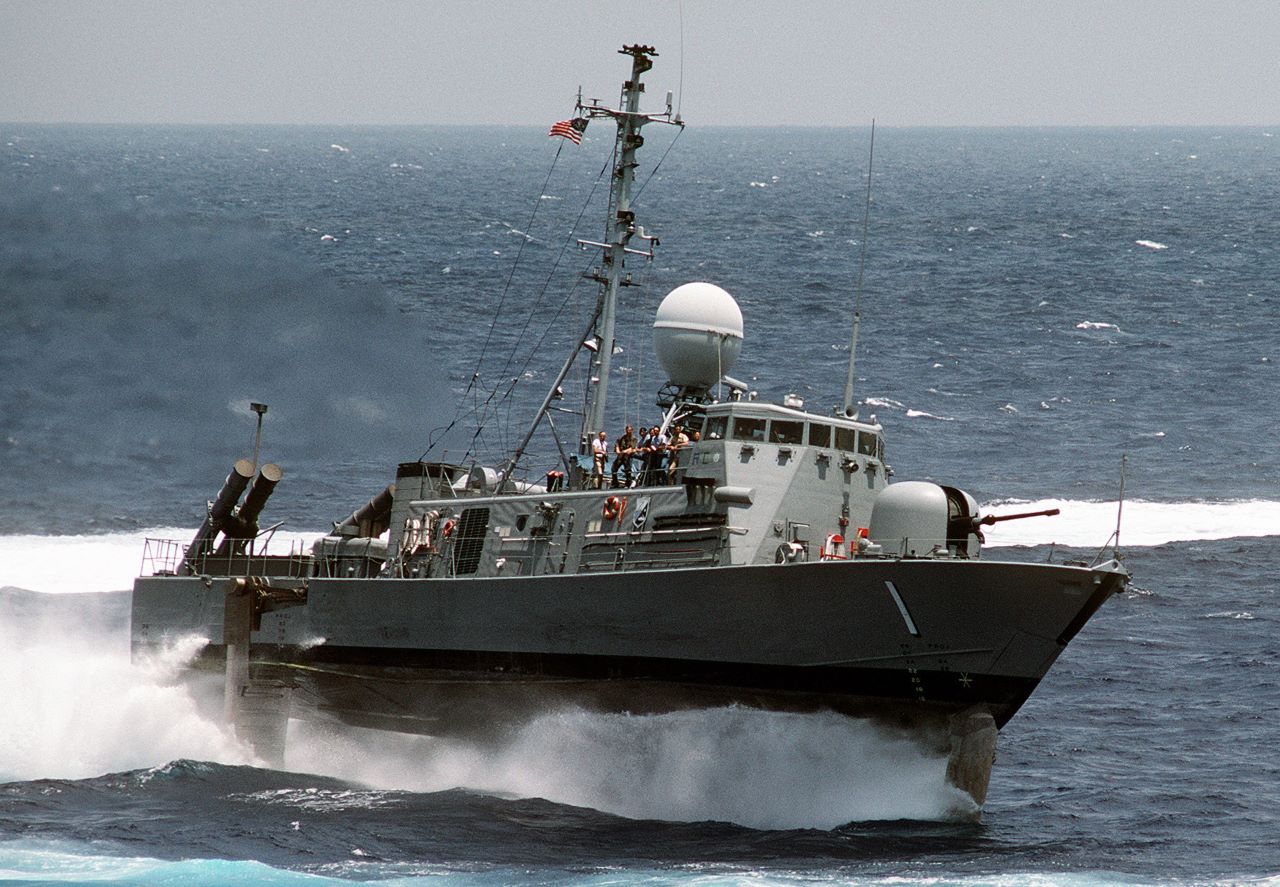
Pegasus at speed
The USN was also very interested in the technology, and after buying several demonstrators, went ahead with a group of six operational hydrofoil missile/gunboats, the Pegasus class. These were also Boeing-built, based on the same technology as the ferries being produced at the time, and were armed with a 76 mm gun and Harpoon missiles. Unfortunately, after they were completed, it turned out that nobody was quite sure what mission they were supposed to serve,7 and they ended up spending most of their service lives in the Gulf of Mexico chasing drug runners, where their high speed was at least somewhat useful. The Italians built seven units of a much smaller missile hydrofoil design, and three more were built in Japan for their navy, all of which have now been retired. The USN did investigate building even larger hydrofoils, up to a 3000-ton destroyer escort, DE(H), but details are sparse and the program never went anywhere.
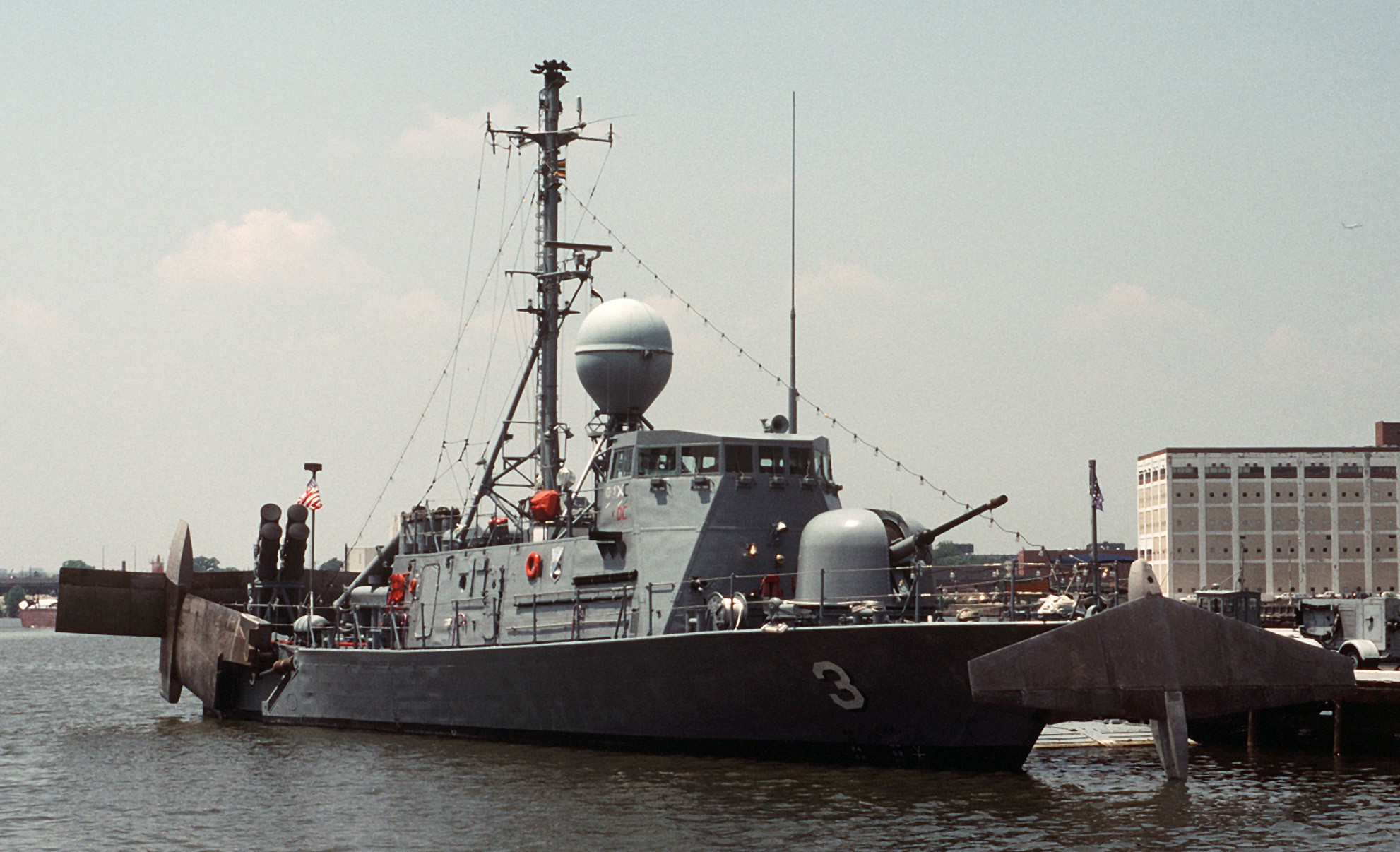
USS Taurus showing off her foils
So what accounted for the failure of the hydrofoil as a type? The biggest single problem was that they turned out to be pretty expensive to operate, largely because water has a surprising amount of stuff suspended in it, and running a precisely-shaped wing through it at 45-60 kts tends to result in the wing eroding out of shape and having to be replaced. But hydrofoils are also extremely weight-critical, which prohibited hydrofoil ferries from carrying cars and made the military versions tricky to upgrade. To get up on its foils, a hydrofoil has a weight-dependent minimum speed,8 which must be below the maximum speed it can reach in non-foiling mode.9 This also tends to give a hydrofoil an operationally unpleasant set of speed options. Most military hydrofoil proposals had two sets of engines, typically diesels for hull-borne cruising operations and a gas turbine for foiling, but the diesels generally couldn't drive the vessel very fast, thanks in part to the drag of the foils, with Pegasus being limited to 12 kts on diesels. While the minimum foiling speed isn't clear, it's probably somewhere above 30 kts, meaning that working with other vessels is completely impossible.
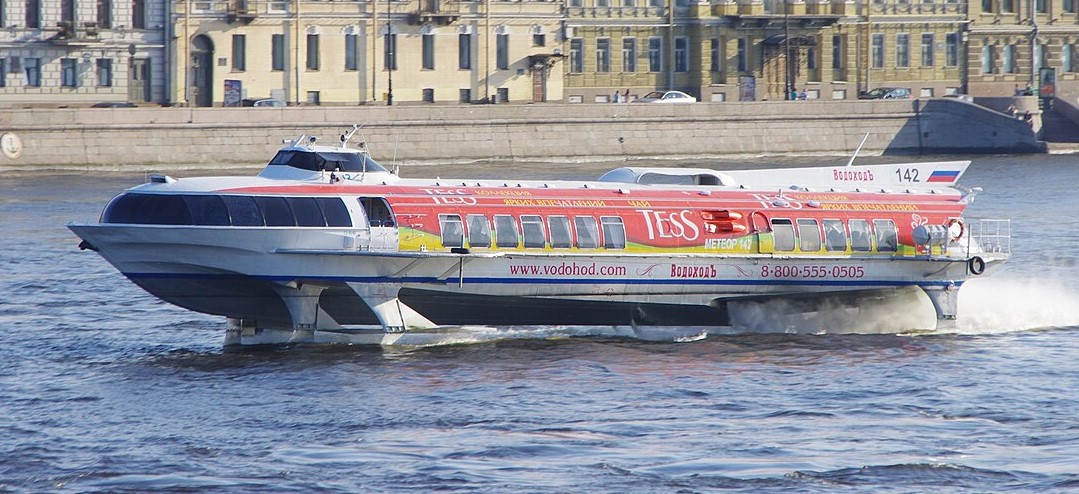
A Russian Meteor-type hydrofoil, showing a stepped hull to aid planing
Nor were these the only problems faced by hydrofoils. Most operational models topped out around 45 kts, because beyond this speed, cavitation on the foil became a serious issue. Supercavitating foils, which could operate at higher speeds, were investigated, but other options simply worked better if you wanted to go that fast. And figuring out how to propel the craft was a serious issue in the 70s, because the engines were in the hull and the propellers had to be in the foils. Some versions used a mechanical shaft in the foil stalks driving a propeller, although the Boeing hydrofoils instead used a waterjet system that involved capturing the water, running it up the stalk into a pump inside the hull, pressurizing it, then sending it back down to be expelled down below. If hydrofoil construction were to resume, both methods would undoubtedly be replaced by electrical transmission.
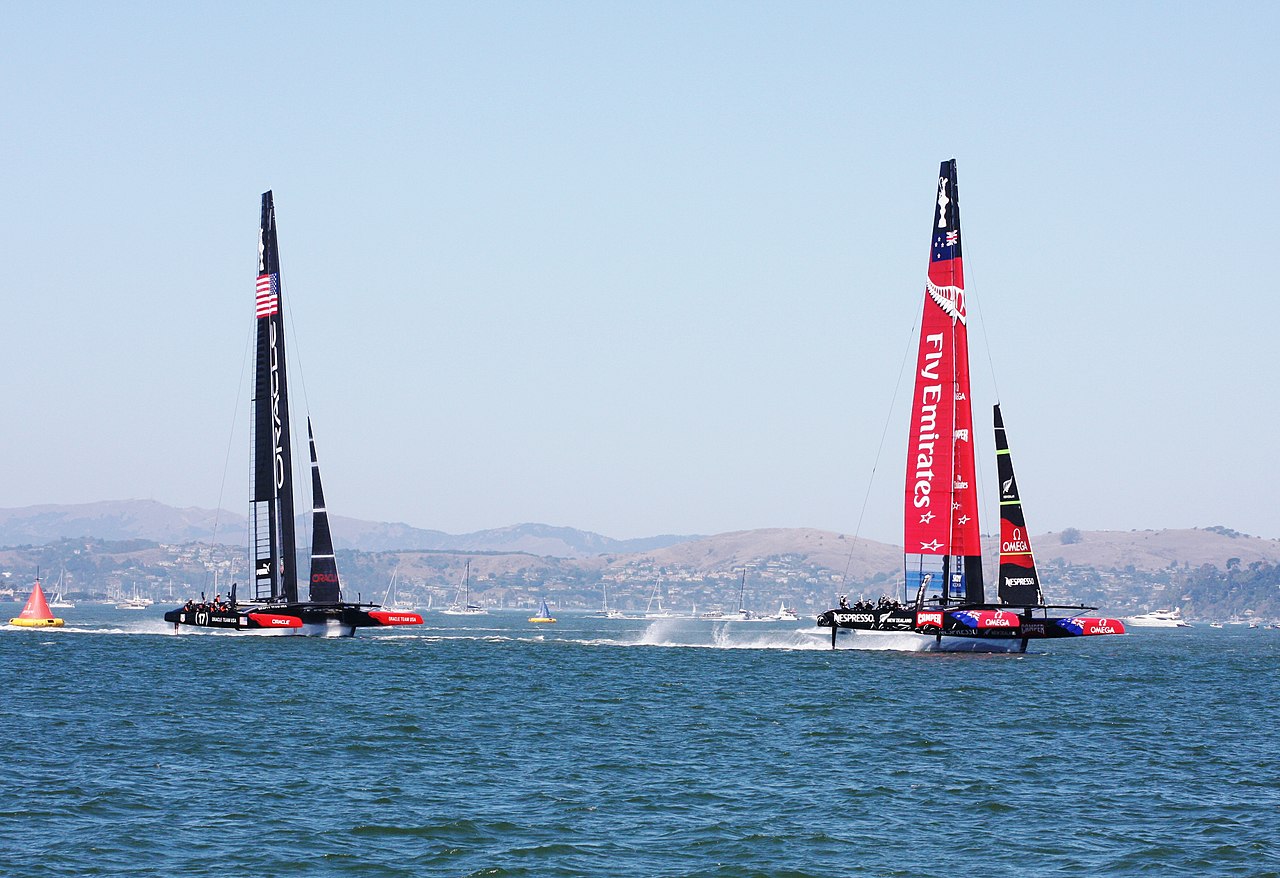
Foiling catamarans compete in the 2013 America's Cup
More broadly, hydrofoils occupied an odd space between boats and aircraft, with the term "flying" often used to describe their condition while foilborne, and the need for minimum weight meant that things were generally constructed to aircraft standards, which caused problems in rough seas or after prolonged exposure to the maritime environment. As a result, the military hydrofoil is essentially dead, and the commercial version is not in great shape either, having had its market eaten by catamarans and trimarans. However, it has found a very successful market niche in the world of recreation, with high-speed sailboats and surfboards showing significant benefits from the technology.
1 Yes, I know that this is not the common explanation for how a wing works. The standard explanation is mostly wrong. You can absolutely get lift from a flat plate, easily verified by sticking your hand out the window of a moving car, although it is made easier in this case by the fact that the water is only on one side of the "wing". ⇑
2 Although note that the desire to maximize bottom area frequently means that a planing vessel is very wide relatively to a displacement vessel. ⇑
3 Despite my phrasing, I'm not sure this is wrong. The issue wasn't really settled before people stopped building the things. ⇑
4 It's also worth mentioning that German coastal craft didn't actually plane. The E-boats had a conventional rounded hull, and did a trick with their rudders known as the Lurssen effect to change the flow around the stern and significantly reduce drag at high speed. ⇑
5 This is called "angle of attack", and more angle of attack means more lift, up to a point, when it pretty much stops making lift. ⇑
6 Pretty much all American hydrofoils came from airplane companies. Boeing was the only one to actually sell them commercially, although the business was sold to Kawasaki Heavy Industries when it became clear that hydrofoils weren't going to take over the world. ⇑
7 The only concrete example I have found of a hydrofoil's speed proving distinctly useful was HMS Speedy, when employed on fishery protection. She was fast enough that her general location wasn't known to fishermen, and she could go from "over the horizon" to "alongside" fast enough that they couldn't change illegal nets. ⇑
8 This can be extremely critical, to the point that the captain of HMS Speedy was given a single pint of paint and told to make it last 2 years. ⇑
9 Some versions also have a minimum foiling weight, presumably due to control system setup, which in the case of the American High Point, limited it to 6 hours of foilborne operation before it became too light and had to stop. ⇑

Comments
I recall a similar story in Brown's Rebuilding the Royal Navy about experiments with extremely fast (40+ knot) conventional frigates, where they reckoned they might be able to get the working life of the propeller up to a whole day at maximum speed.
The Lurssen effect is intriguing. I've never been able to wrap my head around how it actually works, and my intuition says that it should have the opposite effect. But it seems to have given the Germans up to 40 knots out of a 100-ton displacement hull that could operate reliably in the North Sea. And as far as I can tell, nobody else has used it.
@AlanL
I think that was down to cavitation, not erosion, but I didn't see it in a quick check of the book, and don't want to go digging for that passage.
@John
Yeah, I didn't know about it until I was researching this post, and didn't feel like adding yet more mystery to my plate.
The "standard explanation" (venturi effect due to upper wing curvature) annoys me a lot, and has ever since I found out "they" lied to me.
Hovercraft for part 4?
FWIW, many years ago I was at the old Charleston(SC) Navy Yard, and ran across three of the PEGASUS class hydrofoils. No idea which ones; this was after their decom and all identifying numbers had been painted out. I can tell you this - those little so and sos were SMALL.
@ike
Ekranoplans!?!
I see I'm going to need to increase security on my plans again.
Regarding footnote 1: I thought the wrongness of the common (Bernoulli) explanation was itself common knowledge, and easily illustrated by thought experiments like ‘then how can aircraft fly upside down.’ Have you actually encountered that explanation in the wild? advanced seriously and not just as a foil (hah) to be demolished?
Not recently, but I also have an aerospace engineering degree and don't read the sort of stuff where that explanation shows up.
Not only have I encountered the Bernoulli wing explanation in the wild, but the guy proclaiming it was using it to prove that Newton's laws of motion do not apply to fluids, and hence... (Actually, I forget just where he went from there. It was some insane chain of logic that concluded with therefore the western powers are lying to you and we all need to adopt vegan communism. Literally, that's where he ended up.)
In the MUSAM, the Italian Air Force Museum of Vigna di Valle, there is a small hydrofoil boat by Crocco and Ricaldoni, and the AMI has it as it was used to help design the first Italian military airship.
I am also wondering about damage resistance -- regular ships are vulnerable to propeller/rudder damage (cf. some German battleship something something WW II), and hydrofoil craft would seem to have added many places of similar vulnerability around the hull.
And then there's running into fish, or logs, or one of the many other things that might be in the water...
Missing something? Can't parse that sentence.
@Tony
I don't recall seeing anything about that, and I think the defense is that while a battleship is expected to survive hits, even the biggest hydrofoil was small enough that it was expected to die in one hit anyway.
@EngineOfCreation
Editing error on my part, now fixed.